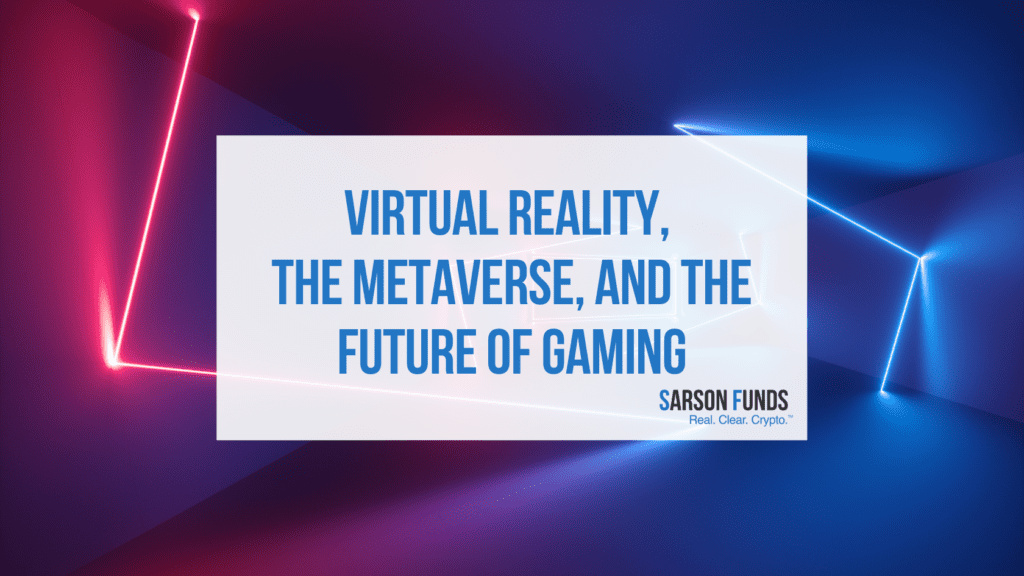
Recent technological achievements have set the gaming industry toward exponential advancements. Video games are becoming impressively more realistic and reflective of real-life scenarios like sports games in NBA 2K and even concerts, like Marshmello’s historic performance in Fortnite. Progress in technology has allowed for Virtual Reality (VR) to allow humans to enter into and play games inside the metaverse using panoramic-view headsets and a player’s physical motor movements. As access to virtual reality experiences grow, so will one’s capabilities inside the metaverse. This article will give an overview of Virtual Reality, the Metaverse, and how a VR metaverse is the future of gaming. For more information on these topics, please visit the Sarson Funds VR Gamer’s Guide to NFTs.
What is Virtual Reality?
Virtual Reality is an immersive technology that bridges the gap between physical human movements and digital interactions. Unlike traditional console and handheld gaming, VR gives you, the player, the ability to control your virtual environment and experience with real motor movements. Virtual reality experiences utilize a 360 degree-view headset that gives users a panoramic view along with a fully immersive and realistic experience. VR leaders include Microsoft, Google, and VAIL VR.
What is the Metaverse?
As Virtual Reality games develop, so will VR’s integration with the Metaverse. The Metaverse is the digital universe and is argued by many to be the next frontier of innovation and exploration. “The metaverse” is used to describe what the future of the internet and our personal interactions will look like in a virtual world. Instead of chatting, gaming, and interacting with friends or the community in chat rooms or groupchats, the metaverse is the digital realm where internet users’ avatars can meet up in a virtual, multi-dimensional space as people do in the real world. Some leading metaverse projects include Decentraland and Sandbox.
The metaverse is most prominently displayed in Steven Spielberg’s film, Ready Player One, where users wear advanced virtual reality suits and headsets to allow one to interact with the virtual world in any way they like. The future of VR is likely to include a similarly as immersive and realistic experience.
What would a Virtual Reality Metaverse Look Like?
Imagine a digital world where instead of pulling out your phone to listen to your favorite song, you could virtually walk inside a digitally attended stadium and watch a live performance from Guns and Roses despite being physically located in your living room. Virtual experiences can take place without you leaving your home, all while your Avatar has the ability to explore any part of the digital universe. With a virtual reality metaverse, the gaming industry will set course toward a new horizon.
How is VR the Natural Evolution of Gaming?
The gaming industry as a whole has seen major improvements over the years. From simple games such as Pong with a single joystick on the Atari CSV, to playing first-person-shooter and strategic games like Call of Duty on an advanced graphics processor on the Play Station 5 with access to online gameplay, gaming has evolved immensely since its inception in the 1970’s. One thing has stayed fairly constant throughout game development, however: Players interact with the game from either a handheld console or a controller to command the actions their characters perform on a screen. Modern gaming is adapting so rapidly that players are wanting a more immersive experience within these games instead of solely engaging from the outside. Virtual reality has responded to these demands and allows gamers to fully immerse themselves into gaming universes. Instead of pressing a button to pick up an in-game weapon, virtual reality allows players to actually reach down to pick up a digital weapon with their hands and swing that weapon in a game. VR gaming is revolutionizing the way the world interacts in the digital realm as digital experiences become more prominent in 21st century human routines.
VR leaders like VAIL VR are demonstrating how virtual reality metaverses can be places for gamers to hangout, socialize, team up in strategic first-person shooter (FPS) games and much more. VAIL VR is becoming a place for gamers to fully immerse themselves in virtual reality gameplay and turn VR into a living commonplace for social interaction. As alternative VR projects follow suit, virtual reality is primed to enable a metaverse of fully immersive gameplay, socialization, and community.
For a deeper dive into the future of virtual reality and gaming, stay tuned to our weekly Gamer’s digest and read the Sarson Funds VR Gamer’s Guide to NFTs, here.
By Zachary Profeta and Liam McDonald
Disclosures: Not investment advice. It should be assumed that Sarson Funds or its affiliated managers hold positions in all projects that are discussed. It is not possible to invest in any project directly through Sarson Funds, Inc. or its affiliated managers. Any investment product offered by managers affiliated with Sarson Funds should be assumed to be only available to Accredited Investors and subject to the individual terms and conditions of that offering including but not limited to those eligibility requirements associated with U.S. Securities Regulation D, section 506c. Talk with your financial advisor before making any investment decisions or have them contact Sarson Funds directly at [email protected]









